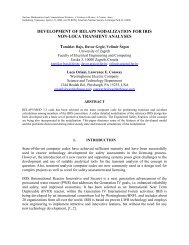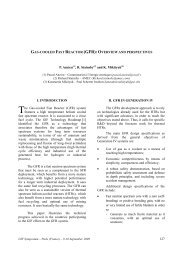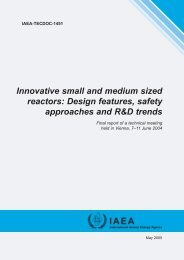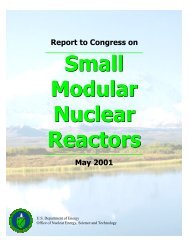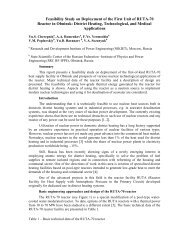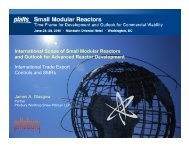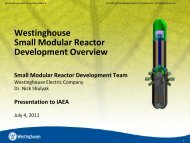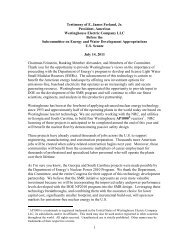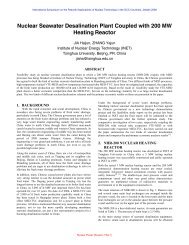Economic and Employment Impacts of Small Modular Reactors - SMR
Economic and Employment Impacts of Small Modular Reactors - SMR
Economic and Employment Impacts of Small Modular Reactors - SMR
- No tags were found...
You also want an ePaper? Increase the reach of your titles
YUMPU automatically turns print PDFs into web optimized ePapers that Google loves.
High Case Domestic<br />
EIA Energy Market <strong>and</strong> <strong>Economic</strong> <strong>Impacts</strong> <strong>of</strong><br />
H.R. 2454<br />
ACESA Basic Case<br />
Report #: SR-‐OIAF/2009-‐05<br />
Assumes low emissions technologies<br />
including nuclear are developed <strong>and</strong><br />
deployed on a large scale in a timeframe<br />
consistent with CO2 reduction<br />
requirements <strong>of</strong> ACESA legislation.<br />
Table 6: High Nuclear Adoption Scenario<br />
High Case International<br />
IAEA Energy, Electricity <strong>and</strong> Nuclear Power<br />
Estimates for the Period up to 2030<br />
2009 Edition<br />
IAEA High Case<br />
IAEA Report IAEA-‐RDS-‐1/29<br />
<strong>Economic</strong> crisis overcome in the near<br />
future.<br />
Past rates <strong>of</strong> economic growth <strong>and</strong><br />
electricity dem<strong>and</strong>, especially in the Far<br />
East, would essentially resume.<br />
Implementation <strong>of</strong> policies targeted at<br />
mitigating climate change.<br />
Underlying fundamentals point to<br />
continued strong growth in the longer<br />
term<br />
Other Considerations<br />
<strong>SMR</strong> deployment is assumed to capture a percentage <strong>of</strong> the forecasted additions to nuclear generating<br />
capacity. In each <strong>of</strong> the third party studies listed above, nuclear growth comes, in part, at the expense<br />
<strong>of</strong> fossil fuel electricity generation. This is primarily due to expected increasing costs for carbon<br />
emissions. Each <strong>of</strong> the studies also assumes that nuclear capacity additions will be GW scale facilities.<br />
Since <strong>SMR</strong>s have generating capacities more comparable to fossil fuel electric plants, particularly natural<br />
gas plants, it is reasonable to assume that <strong>SMR</strong>s may be better suited to capture market share from<br />
fossil fuel plants than from traditional GW scale nuclear facilities. In addition, <strong>SMR</strong> manufacturers may<br />
be in a position to fill dem<strong>and</strong> currently met by the natural gas <strong>and</strong> coal-‐fired power plants if trade<strong>of</strong>fs<br />
between high initial costs (nuclear) <strong>and</strong> high carbon emissions (fossil fuel) become more evenly<br />
balanced due to environmental policy changes.<br />
While environmental policy changes may lead to larger dem<strong>and</strong> <strong>and</strong> more rapid deployment <strong>of</strong> <strong>SMR</strong>s<br />
than generally assumed, other factors may hinder <strong>SMR</strong> deployment. Issues such as spent fuel storage,<br />
licensing, public acceptance, <strong>and</strong> supply chain factors may prove to be significant over the coming years.<br />
The specifics <strong>of</strong> how these issues are resolved are likely to significantly impact the future <strong>of</strong> small<br />
modular nuclear reactors. Each <strong>of</strong> these is discussed briefly below.<br />
The storage <strong>of</strong> spent fuel is an important one for from both a cost <strong>and</strong> public acceptance perspective.<br />
Domestic firms developing <strong>SMR</strong> designs address the issue <strong>of</strong> spent fuel storage by assuming that spent<br />
fuel will either be stored on-‐site at the <strong>SMR</strong> location or <strong>of</strong>f-‐site at a permanent location. The primary<br />
22



